Introduction
As the technology landscape continues to evolve, embracing serverless architectures like AWS Lambda and Amazon API Gateway is becoming increasingly vital. These services offer a streamlined approach to building responsive, scalable, and efficient applications. AWS Lambda allows you to run code without the need for servers, revolutionizing cloud computing one function at a time.
From drug discovery in the pharmaceutical industry to cultural heritage preservation in libraries, Lambda has proven its versatility and impact across various sectors. Meanwhile, Amazon API Gateway acts as the digital conduit to backend services, ensuring safe API exposure and facilitating seamless interactions between microservices. Together, Lambda and API Gateway empower organizations to enhance customer engagement, improve data management, and bolster API security.
In this article, we will explore the process of setting up AWS Lambda with API Gateway, creating microservices, implementing Lambda authorizers for API Gateway security, configuring Lambda proxy integration, and testing and deploying APIs. We will also delve into advanced use cases and best practices, highlighting the transformative potential of serverless computing in today's technology ecosystems. So, let's dive into the world of AWS Lambda and Amazon API Gateway and unlock the power of serverless architectures.
Understanding AWS Lambda
Embracing AWS serverless computing translates to more than just running code without servers; it's about pioneering the future of cloud computing, one function at a time. For example, at Vertex Pharmaceuticals, utilizing AWS serverless computing has completely transformed the drug discovery process. By using machine learning algorithms, the platform enables the fast and accurate analysis of large datasets from experiments, a task that was previously laborious and time-consuming.
Furthermore, institutions such as the Northwestern University Library (NUL) have utilized a service similar to Lambda in their digital collections suite, incorporating open standards like IIIF to disseminate collections worldwide with effectiveness. This emphasizes the role of the organization in improving collaboration and cultural heritage preservation globally.
The serverless environment also empowers professionals like Rushikesh Jagtap and Tayo Olajide to design and optimize data pipelines across various industries. This leads to insightful analytics solutions that drive business decisions without the overheads of traditional server management.
Advancements in areas such as cancer treatment have been driven by the scalability and security of AWS, as discussed by experts at re: Invent. Generative AI, powered by a powerful computing platform, is enhancing the efficiency and outcomes of cancer diagnosis and drug discovery. In terms of data management, AWS continues to release new capabilities, such as AWS Supply Chain's enhanced forecasting and replenishment features, which benefit from the serverless architecture offered by AWS Lambda.
Moreover, AWS's storage options, such as Amazon S3 Express One Zone, showcase how the function supports services that manage millions of requests per minute, enhancing performance for high-demand applications.
In terms of technology, it symbolizes computing with no administration, which allows developers to be free from the task of managing EC2 instances, operating systems, or scalability concerns. It's a cost-effective platform that's particularly advantageous for prototyping, small teams, or projects where minimal maintenance is key. While serverless is not a panacea for all computing needs, it offers significant benefits where applicable.
Function as a Service (FaaS) epitomizes this approach, enabling the execution of discrete functions in response to specific events, with the cloud provider handling the infrastructure. Initiating with AWS Lambda is straightforward—write your code, package it, upload it, and Lambda handles the rest, including scaling and availability.
The market for serverless architecture is on a significant growth trajectory, with projections estimating its value to reach nearly $96.35 billion by 2032, a testament to the shift towards serverless computing in technology ecosystems.
Understanding Amazon API Gateway
AWS API Gateway becomes a crucial service for developers seeking to simplify the creation, publication, and management of application programming interfaces across various scales. Serving as the digital conduit to backend services, the gateway ensures safe API exposure to external clients. Tasked with the comprehensive handling of API requests, the service expertly manages crucial aspects such as user authentication, data transformation, and request caching.
Consider the scenario at pilot, where the integration of webhooks for real-time data synchronization with third-party systems is paramount for advancing customer service in the energy sector. API Gateway's robustness is instrumental in building features that bolster service capabilities. Similarly, for an e-commerce application dependent on a suite of microservices and a payment processing API, the gateway facilitates seamless interactions. It intelligently orchestrates user management, product information, and order processing, demonstrating its versatility.
Considering the development of application programming interfaces, from the early 2000s when they functioned as business links for companies such as Salesforce and Amazon, to the intricate ecosystems of today, management of these interfaces has become essential. It guarantees protection, oversees efficiency, and handles the life cycle of application programming interfaces. As the digital landscape expands, so does the importance of application programming interfaces, with an astounding 93% of organizations acknowledging their crucial role in preventing operational silos, as reported by Vanson Bourne in 2021.
To illustrate, a metaphorical restaurant can only handle so many orders before service is impacted. Similarly, an API Gateway can impose necessary restrictions to maintain system integrity and prevent overload, much like a maître d' managing guest requests. This strategic management is crucial for large organizations where cohesive API design is critical for adoption and consumption. By documenting APIs centrally and employing methodologies like code-first and design-first, organizations can navigate the complexities of extensive API networks effectively.
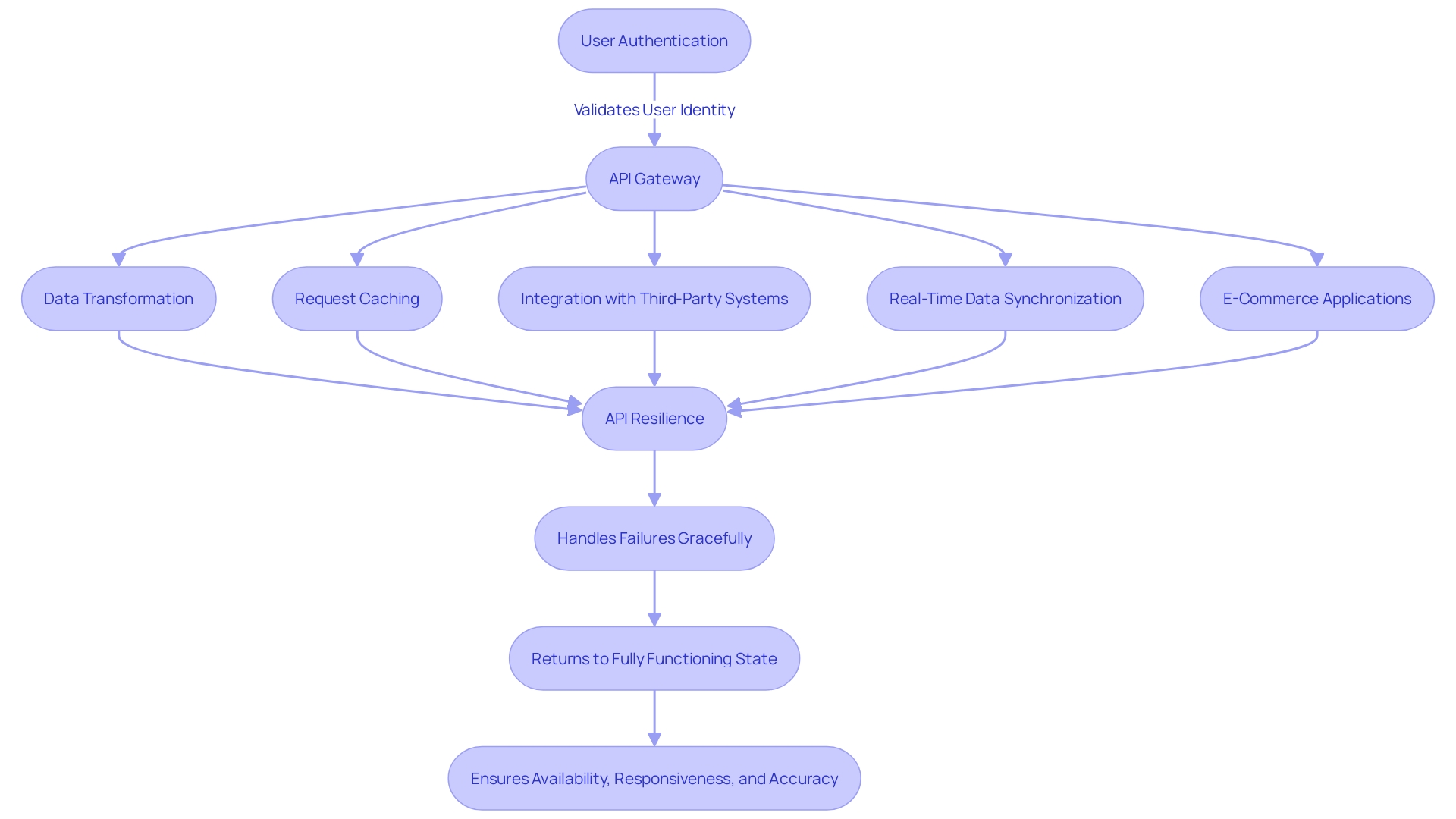
Setting Up AWS Lambda with API Gateway
Setting up AWS Functions with API Gateway is a streamlined process that enables you to create responsive, serverless applications. The journey starts by creating a new function, carefully designed to handle events from API Gateway. This function is the backbone of your application, running your code in response to HTTP requests without the need for provisioning or managing servers.
Once your function is prepared, the next step involves creating a new API in API Gateway, which serves as the entrance to your function. This integration is crucial, as it enables your function to connect with the outside world, allowing it to receive and process API calls.
The culmination of this process is the deployment of your API, which is when your application goes live. It's at this point that you can engage in thorough testing using the API Gateway console, ensuring that everything operates smoothly. By following these steps, your application will be primed to serve requests in real-time, showcasing the power and flexibility of AWS and API Gateway.
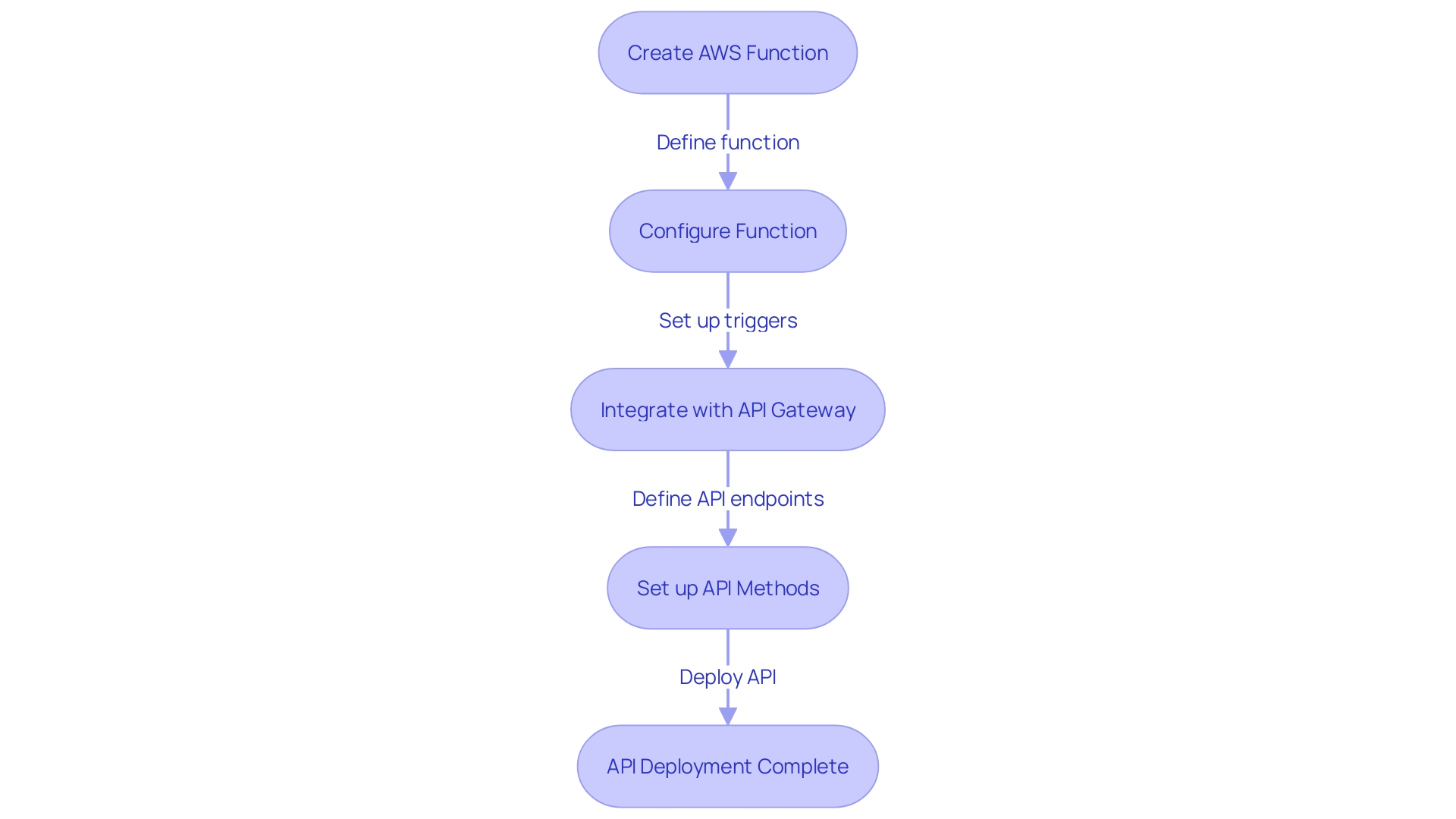
Creating a Simple Microservice Using Lambda and API Gateway
Utilizing AWS and API Gateway, organizations can effectively build and deploy microservices to enhance their digital offerings. Take the example of a technology team that successfully transitioned from a monolithic architecture to microservices, capitalizing on the flexibility and scalability that such an architecture provides. A function, focused on a single responsibility, can be written to perform tasks such as data retrieval or file processing. Afterwards, API Gateway can be set up to handle and direct incoming requests to the function. The synergy between these AWS services facilitates the creation of a robust microservice, accessible via a RESTful API. With microservices like LiveWell by Zurich, which is revolutionizing the digital health and wellbeing space, there is a clear demonstration of the potential to improve customer engagement through technology solutions. As the technology landscape constantly changes, the acceptance of serverless architectures is gaining popularity, with research indicating that 93% of organizations view interfaces as vital to their operations. By embracing serverless technologies such as AWS Lambda, companies can focus on innovation and customer satisfaction without the overhead of server management, as AWS manages the underlying infrastructure. This not only simplifies development but also aligns with the growing significance of microservices and application programming interfaces in attaining organizational efficiency and agility.
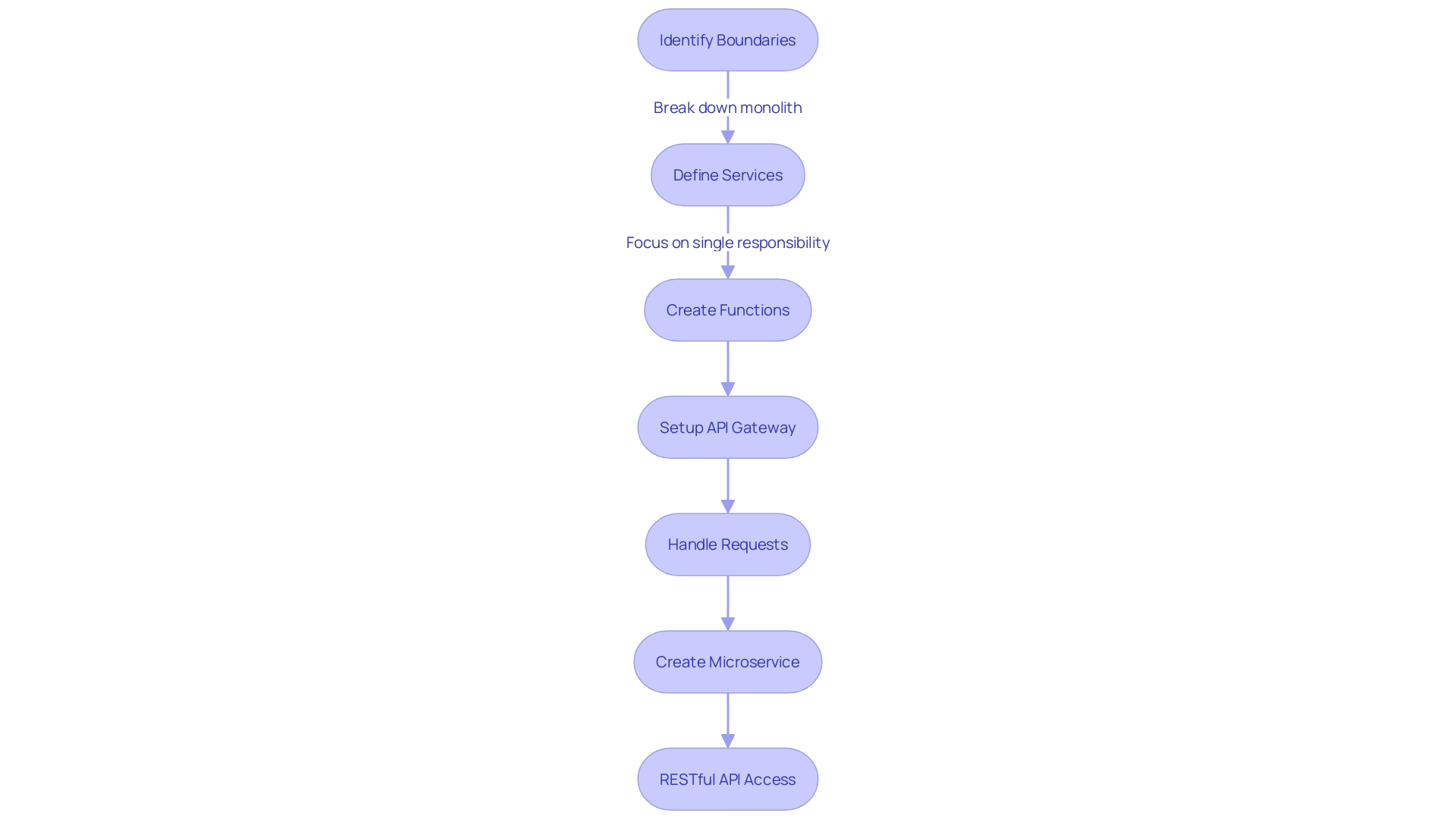
Lambda Authorizers for API Gateway Security
Protecting your APIs is paramount in today's digital landscape, where threats lurk at every corner. AWS authorizers offer a robust mechanism to secure your API Gateway endpoints with custom authentication logic. When you utilize authorizers, you have the flexibility to write authorization logic tailored to your unique security needs, effectively mitigating the risk of unauthorized access. By using functions as authorization gatekeepers, you can ensure that all incoming requests are scrutinized before gaining entry to your API resources.
This strategic approach to API security is not merely speculative; it is grounded in real-world application. Consider the case of CloudFlare, which handles a massive influx of API traffic, accounting for over half of its dynamic network activity. CloudFlare's focus on API security, as outlined in its extensive Security Report for 2024, highlights the importance of safeguarding application programming interfaces against cyber threats. Through vigilant management of credentials and stringent enforcement of security practices like multi-factor authentication, Cloudflare sets a precedent in API defense.
To enhance your API security using AWS Lambda, start by scripting a function that embodies your authorization criteria. Next, integrate this function with API Gateway, configuring it as a custom authorizer. This integration ensures that your APIs are shielded by the precise security logic you've codified in your function. The integration process itself is streamlined, thanks to managed policies that spare you from the minutiae of policy creation, allowing you to focus on the logic that matters most.
For a practical understanding of how to implement this security architecture, GitHub offers a repository with sample code to guide you through the setup. You can clone this repository and apply the code to test the solution in a controlled environment before deploying it in a production setting.
To sum up, by using authorizers, you can build a strong line of defense for your API Gateway endpoints, strengthening your organization against the increasing wave of cyberattacks targeting APIs. Embrace this advanced security measure and write the future of cloud computing—one function, one policy, one secure API at a time.
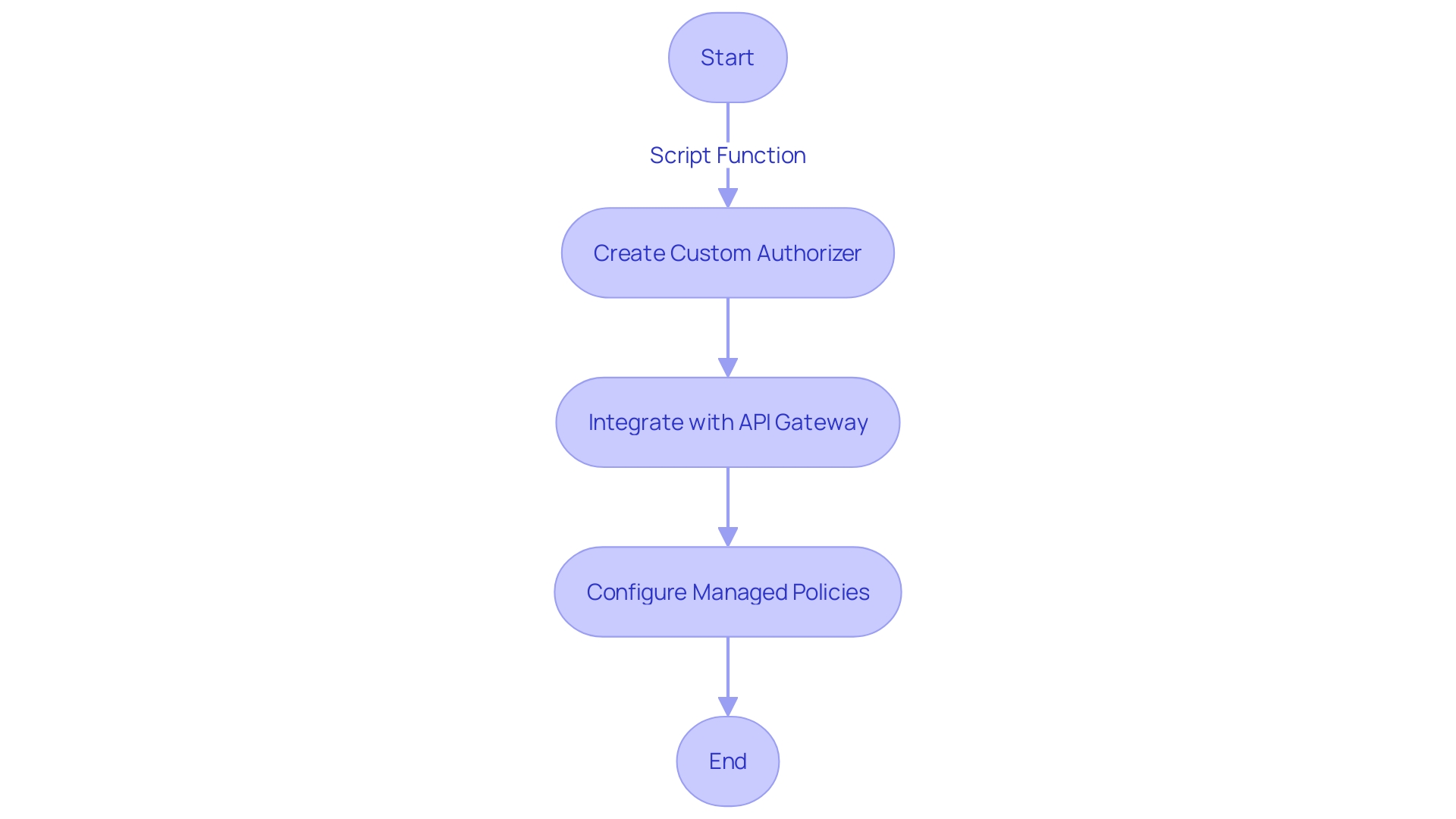
Configuring Lambda Proxy Integration
API Gateway's proxy integration is a pivotal feature for building serverless architectures. It acts as a conduit, streamlining the data flow between API Gateway and AWS Function. By leveraging this integration, developers can create robust applications that are both scalable and efficient. The integration simplifies the backend code necessary for API operations, allowing functions to directly handle incoming requests and return responses. This design is particularly useful when developing web applications requiring distinct functionalities such as user authentication, data storage, and email notifications. Each aspect can be encapsulated within its own function, providing modularity and ease of management.
Furthermore, proxy integration becomes invaluable when migrating existing applications to a serverless model. It allows the smooth transition of RESTful interfaces to AWS Lambda without extensive rewrites. This flexibility is critical in today's fast-paced technology landscape where adaptation to serverless computing can catalyze innovation and reduce operational burdens. The integration also aligns with the industry's forward-thinking stance on application programming interfaces, which are now more crucial than ever in facilitating collaboration and driving progress in various sectors. As demonstrated by recent research, the unanimous agreement among organizations is that application programming interfaces are crucial for dismantling silos and promoting an integrated technological ecosystem.
In summary, configuring Lambda proxy integration is not just a technical step but a strategic move towards a serverless future, where the full potential of cloud computing can be harnessed, amplifying development productivity and customer satisfaction.
Testing and Deploying Your API
Creating robust application programming interfaces (APIs) is crucial in the digital environment where reliability and effectiveness are essential. Resilience in the API context entails the capacity for consistent and reliable functionality amidst challenges such as high traffic, errors, or unexpected conditions. Instead of merely avoiding failures, the focus is on acknowledging their inevitability and crafting a response strategy that minimizes downtime and data loss. The ultimate objective is to restore the application to optimal functioning post any incident. This concept is integral to modern software development where application programming interfaces serve as vital conduits for system interaction, enabling complex services and functionalities.
Testing methodologies play a crucial role in reinforcing API resilience. Employing a variety of tests, including unit, integration, and load tests, is essential. For instance, integration tests examine individual applications' interaction with other services without necessitating the operation of those services, such as in Docker. These tests might include synchronous or asynchronous communication and are distinct from end-to-end (E2E) tests. Additionally, when crafting tests for data integrity, such as in scenarios where differing data formats are used across systems during migration periods, it is imperative to determine the validity of the data against the expected formats.
Deployment strategies must also be considered, focusing on version control and seamless updates to avoid API version incompatibility issues. The use of tools like Postman, which facilitates request construction and execution, supports these testing and deployment processes by ensuring that application programming interfaces are not only technically sound but also user-friendly and secure against cyber threats.
Moreover, comprehending the importance of application programming interfaces is underpinned by statistics revealing that 93% of organizations recognize their relevance, with 86% acknowledging that APIs prevent operational silos. Furthermore, 97% of industry professionals concur that application programming interfaces and microservices are complementary, highlighting the shift towards integrated, high-performing application programming interfaces that utilize both to improve customer satisfaction, productivity, and efficiency.
In summary, by integrating these best practices and insights into the development cycle, teams can ensure that APIs are not only robust and resilient but also contribute to a seamless and secure end-user experience.
Advanced Use Cases and Best Practices
AWS, together with API Gateway, presents an advanced ecosystem for serverless computing, enabling developers to construct versatile, event-driven architectures. At the heart of this system lies the ability to process asynchronous events and optimize performance seamlessly. An illustrative example of such an implementation is ePilot's integration of webhooks for efficient third-party data synchronization, which underscores the importance of timely updates in the energy sector. By leveraging AWS's API Destinations, epilot has significantly enhanced its service capabilities.
In the realm of AWS, beginning is simple: code is written, packaged, and uploaded, with the service handling scaling, resource management, and availability. The service's support for multiple languages, including Node.js, Python, Java, Go, and. NET Core, provides the necessary flexibility to match the application's requirements. This versatility is a testament to AWS's commitment to fostering a serverless future where operational overhead does not impede innovation. For those who prefer a visual learning experience, a video summary available on YouTube complements this discussion with dynamic content.
Beyond individual functions, AWS Cloud Development Kit (CDK) applications, structured around domains such as orders, inventory, and payments, promote maintainability. Key technical features like Change Data Capture (CDC) and observability are integral to this architecture. The imperative nature of CDK coding offers various pathways to achieve logical resource organization.
The application of AI in healthcare, as discussed at re: Invent, is an example of serverless architectures' broader impact. Here, the scalability and security of AWS cloud services play a pivotal role in advancing cancer care, demonstrating the transformative potential of such technologies. Similarly, AWS continues to innovate with recent launches, including new capabilities for AWS Supply Chain and a palm recognition identity service, further simplifying operations and data management.
The integration of serverless computing in modern architectures can be fraught with pitfalls. Costly lessons learned over the years pertain not just to financial aspects but also to challenges in troubleshooting and architectural design. A thorough understanding of event-driven architecture is crucial, as events are the lifeblood of such systems, triggering actions or responses that are integral to real-time data processing, microservices, IoT applications, and systems demanding high concurrency and responsiveness.
Lastly, while considering the implications of cold starts on AWS Lambda, it is essential to deploy workloads, test under meaningful load, and measure outcomes before optimizing, following Donald Knuth's caution against premature optimization. This strategic approach ensures that optimization efforts are well-directed and impactful, aligning with the overarching goal of maximizing serverless computing benefits.
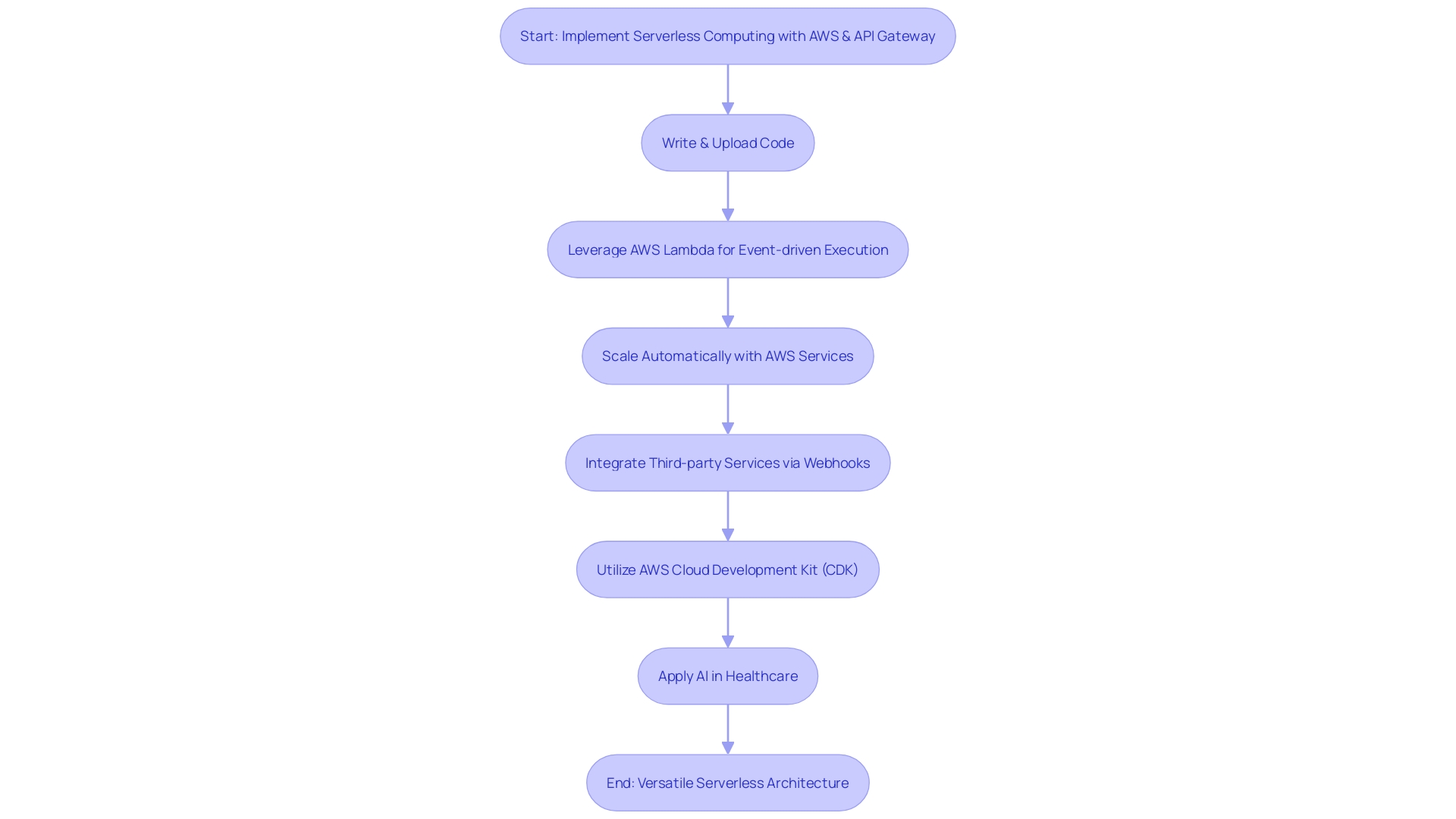
Conclusion
In conclusion, AWS Lambda and Amazon API Gateway are essential components in today's technology landscape. Lambda revolutionizes cloud computing by enabling code execution without servers, while API Gateway acts as the digital conduit to backend services, ensuring safe API exposure and facilitating seamless interactions between microservices.
Setting up AWS Lambda with API Gateway is a streamlined process that allows organizations to create responsive, serverless applications. By crafting a Lambda function tailored to handle events from API Gateway and establishing a new API, organizations can connect their functions with the outside world and deploy their applications live.
Lambda authorizers provide a robust mechanism to secure API Gateway endpoints with custom authentication logic, protecting against unauthorized access. Configuring Lambda proxy integration simplifies the data flow between API Gateway and Lambda, enabling the creation of scalable and efficient applications.
Testing and deploying APIs are crucial for ensuring resilience and dependability. Employing various testing methodologies and deployment strategies, such as version control and seamless updates, helps avoid compatibility issues and maintain optimal performance.
AWS Lambda and API Gateway offer advanced use cases and best practices for serverless computing. Leveraging features like AWS Cloud Development Kit (CDK) applications and Change Data Capture (CDC) promotes maintainability and logical resource organization.
By embracing AWS Lambda and Amazon API Gateway, organizations can build responsive, scalable, and efficient applications. Following best practices and leveraging the advanced features of these services unlocks the transformative potential of serverless architectures in today's technology ecosystems.




